Archive:Impact of COVID-19 on international trade by main partners
Data extracted in April 2021.
Planned article update: April 2022.
Highlights
In 2020, the largest drops in EU exports and imports in absolute terms were with Russia, the United States and the United Kingdom.
EU imports from Russia and Norway fell most during 2020 compared with 2019
EU exports to India and the United Kingdom fell most during 2020 compared with 2019
To help prevent the spread of the COVID-19 pandemic, countries around the world have taken a variety of restrictive measures, which have negatively affected international trade in goods. This article is part of an online publication containing articles on the Impact of COVID-19 on international trade in goods statistics. In this article, we present the impact on trade with the EU's ten main partners. To ensure comparability over time, seasonally and working-day adjusted data are used.
Full article
Comparison with the previous year
The EU largest trade in goods partners are the United States, China, the United Kingdom and Switzerland (See Figure 1). Trade with the United Kingdom and the United States suffered most from the COVID-19 crisis, with big drops in exports in April 2020 and in imports in May. Although trade recovered afterwards, it was still lower than before the crisis in December 2020. Trade with Switzerland also dropped somewhat less in April and had rebounded to pre-crisis levels in December 2020. Trade with China decreased early in the crisis, but to a lesser degree and by December 2020 was well above pre-crisis levels. The contrasting developments in trade with China and the United States meant that in April 2020, China overtook the United States as the largest trade partner of the EU and continued to be the largest partner since then.
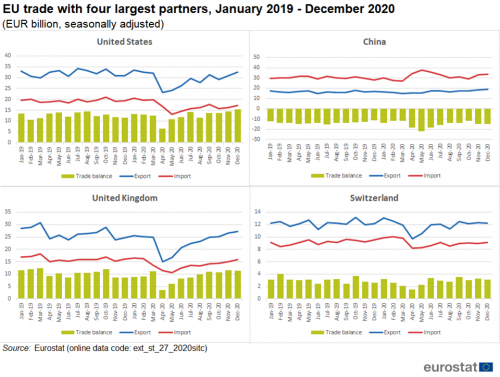
Source: Eurostat (ext_st_eu27_2020sitc)
In 2020, imports from all main partners except China dropped compared with 2019 (see Figure 2). The largest drops in absolute terms (i.e. subtracting 2019 imports from 2020 imports) were in imports from Russia (- EUR 48 billion), the United States (- EUR 30 billion) and the United Kingdom (- EUR 27 billion). In relative terms (i.e. dividing 2020 imports by 2019 imports) the largest drops were in imports from Russia (-33 %), Norway (-22 %) and India (-17 %). The large drops for Russia and Norway were due to strongly reduced imports of energy products, while for India the largest contributor to the drop was other manufactured products.
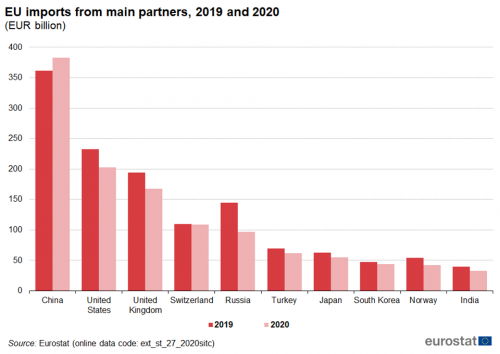
Source: Eurostat (ext_st_eu27_2020sitc)
In 2020, exports to all main partners except China, South Korea and Turkey dropped compared with 2019 (see Figure 3). The largest drop in absolute terms (- EUR 42 billion) was in exports to the United Kingdom where the combination of the COVID-19 crisis and uncertainty over Brexit led to a 13 % drop. In relative terms, only exports to India suffered a larger drop of 16 %. For both these countries machinery and vehicles were the product group with the largest decrease in exports. Exports to Japan and Russia also had double digit drops.
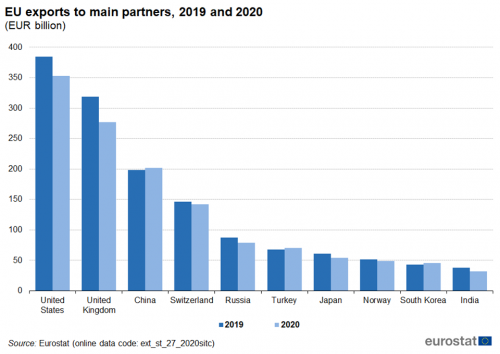
Source: Eurostat (ext_st_eu27_2020sitc)
Figure 4 shows the growth rates of trade for the main partners of the EU-27, comparing 2020 with 2019. For all partners except China and Switzerland the growth rate for imports was below the growth rate for exports. The gap between the two was largest for Russia and Norway.

Source: Eurostat (ext_st_eu27_2020sitc)
Table 1 compares the imports by quarter in 2020 to the same quarter in 2019. The second quarter saw the sharpest decline for all partners except China and South Korea. Imports from China fell only in the first quarter, while imports from South Korea fell most in the third quarter. In the third quarter there were double digit drops for all partners except China, Turkey and Switzerland. In the fourth quarter double digit drops were only seen for Russia, Norway and the United States.
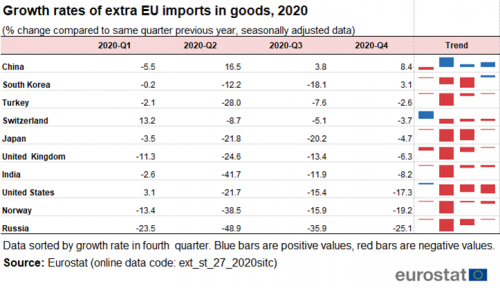
Source: Eurostat (ext_st_eu27_2020sitc)
Table 2 compares the exports by quarter in 2020 to the same quarter in 2019. The second quarter saw the sharpest decline for all partners except China and Japan. Imports from China fell most in the first quarter, while imports from Japan fell most in the third quarter. In the third quarter there were double digit drops for Japan, Russia, the United Kingdom and the United States. In the fourth quarter only Russia had a double digit drop while exports to South Korea, Turkey, China, the United Kingdom and Norway increased compared to the fourth quarter of 2019.
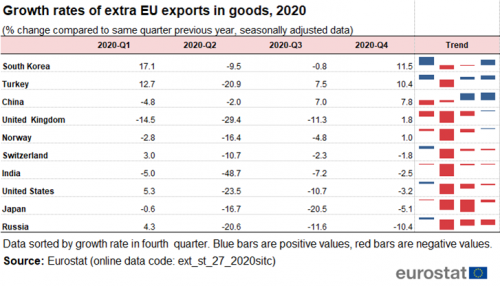
Source: Eurostat (ext_st_eu27_2020sitc)
Quarter to quarter comparison
Table 3 compares the imports by quarter to the previous quarter. The second quarter saw the sharpest decline for all partners except China. However, in the next quarter, imports from six of the ten main partners (United Kingdom, Russia, India, Turkey, Switzerland and the United States) increased compared to the previous quarter. For South Korea, Japan and Norway the best quarter in 2020 was the fourth quarter while for China it was the second quarter.

Source: Eurostat (ext_st_eu27_2020sitc)
Table 4 compares the exports by quarter to the previous quarter. The second quarter saw the sharpest decline for all partners except China. Exports to China fell most in the first quarter of 2020. However, the growth in the third quarter compared to the second quarter was largest for all partners except South Korea and Japan. The latter two both had double digit growth in the fourth quarter compared to the third quarter, as did India, the United Kingdom and Turkey.
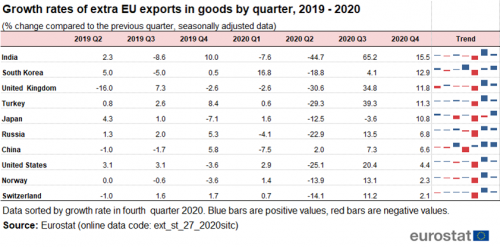
Source: Eurostat (ext_st_eu27_2020sitc)
Source data for tables and graphs
Data sources
EU data is taken from Eurostat's COMEXT database. COMEXT is the reference database for international trade in goods. It provides access not only to both recent and historical data from the EU main partners but also to statistics of a significant number of third countries. International trade aggregated and detailed statistics disseminated via the Eurostat website are compiled from COMEXT data according to a monthly process.
Data are collected by the competent national authorities of the main partners and compiled according to a harmonised methodology established by EU regulations before transmission to Eurostat. For extra-EU trade, the statistical information is mainly provided by the traders on the basis of customs declarations.
EU data are compiled according to Community guidelines and may, therefore, differ from national data published by the main partners. Statistics on extra-EU trade are calculated as the sum of trade of each of the 27 EU main partners with countries outside the EU. In other words, the EU is considered as a single trading entity and trade flows are measured into and out of the area, but not within it.
The EU-27 data reflect the political change in the EU composition. Therefore, the United Kingdom is considered as an extra-EU partner country for the EU-27. However, the United Kingdom is still part of the internal market until the end of the transitory period, meaning that data on trade with the United Kingdom are still based on statistical concepts applicable to trade between the EU main partners. As a consequence, while imports from any other extra-EU-27 trade partner are grouped by country of origin, the United Kingdom data reflect country of consignment. In practice this means that the goods imported by the EU-27 from the United Kingdom were physically transported from the United Kingdom but part of these goods could have been of other origin than the United Kingdom. For this reason data on trade with the United Kingdom are not fully comparable with data on trade with other extra-EU-27 trade partners.
Methodology
In this article some products are classified as COVID-19 related products. They are compared over time and across countries, and also to products in the same chapter of the Harmonised System (HS) product classification, i.e. they are compared to other similar products that are however not directly used in response to the COVID-19 pandemic. It should be noted that most COVID-19 related products cannot be precisely identified and they are grouped together with products not specific to COVID-19. Nevertheless, some trends can be observed.
According to the EU concepts and definitions, extra-EU trade statistics (trade between EU main partners and non-EU countries) do not record exchanges involving goods in transit, placed in a customs warehouse or given temporary admission (for trade fairs, temporary exhibitions, tests, etc.). This is known as ‘special trade’. The partner is the country of final destination of the goods for exports and the country of origin for imports.
Unit of measure
Trade values are expressed in millions or billions (109) of euros. They correspond to the statistical value, i.e. to the amount which would be invoiced in the event of sale or purchase at the national border of the reporting country. It is called a FOB value (free on board) for exports and a CIF value (cost, insurance, freight) for imports.
Context
Trade is an important indicator of Europe’s prosperity and place in the world. The bloc is deeply integrated into global markets both for the products it sources and the exports it sells. The EU trade policy is an important element of the external dimension of the ‘Europe 2020 strategy for smart, sustainable and inclusive growth’ and is one of the main pillars of the EU’s relations with the rest of the world.
Because the 27 EU main partners share a single market and a single external border, they also have a single trade policy. EU main partners speak and negotiate collectively, both in the World Trade Organization, where the rules of international trade are agreed and enforced, and with individual trading partners. This common policy enables them to speak with one voice in trade negotiations, maximising their impact in such negotiations. This is even more important in a globalised world in which economies tend to cluster together in regional groups.
The openness of the EU’s trade regime has meant that the EU is the biggest player on the global trading scene and remains a good region to do business with. Thanks to the ease of modern transport and communications, it is now easier to produce, buy and sell goods around the world which gives European companies of every size the potential to trade outside Europe.
Direct access to
- International trade in goods (t_ext_go), see:
- International trade in goods - long-term indicators (t_ext_go_lti)
- International trade in goods - short-term indicators (t_ext_go_sti)
- International trade in goods (ext_go), see:
- International trade in goods - aggregated data (ext_go_agg)
- International trade in goods - long-term indicators (ext_go_lti)
- International trade in goods - short-term indicators (ext_go_sti)
- International trade in goods - detailed data (detail)
- EU trade since 1988 by SITC (DS-018995)
- International trade in goods statistics - background
- International trade in goods (ESMS metadata file — ext_go_esms)
- User guide on European statistics on international trade in goods